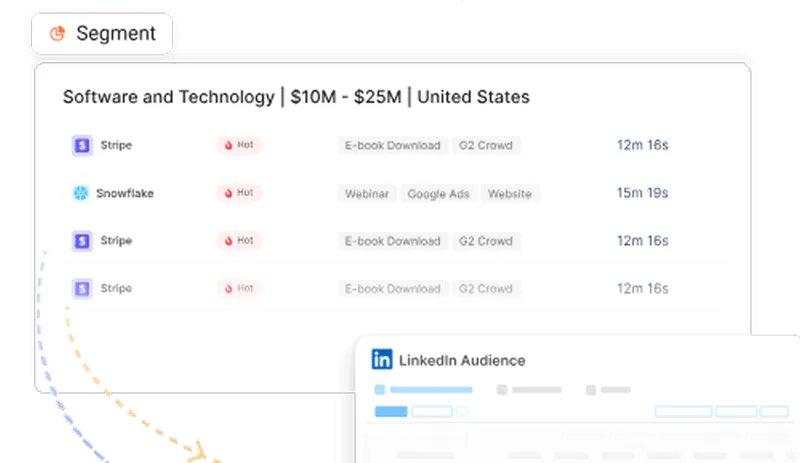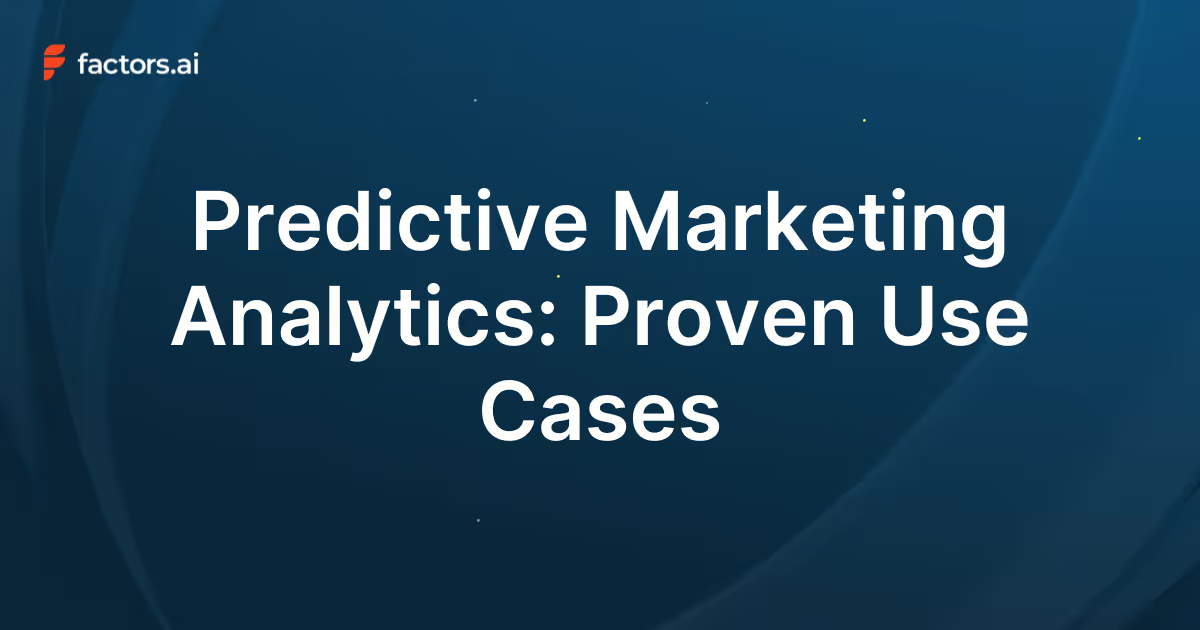Content Marketing Metrics
Discover the essential content marketing metrics to track for measuring your campaign success. Learn more in Factors.ai's latest blog post.
Content is king, and a solid content marketing strategy is your key to B2B success.
According to studies, over 88% of all B2B brands currently utilize content marketing for their everyday efforts, while another 76% of them intend to do so in the future as well.
As per definition, content marketing refers to using a strategy that involves creating and sharing valuable, meaningful content (such as videos, articles, and infographics) with your target audience. This sharing promotes audience engagement, value-addition to your marketing efforts, and above all, a positive brand image.
To explain this better, here's a thumb rule - the more value you provide to your customer, the more likely they are to opt for your products and services. Half-hearted marketing efforts are a thing of the past now, and paying attention to your content strategy is just as important as other aspects of your branding journey.
However, here's a question that you might ask yourself while starting with content marketing - "What metrics do I use to track the performance of my content strategy?"
Well, your search ends here.
In this blog, we'll cover the top content marketing metrics you must track, why these metrics are important as well as FAQs on content marketing metrics.
What Are Content Marketing Metrics and Why Are They Important?
The biggest factor that sets content marketing apart from other strategies is that its goal is not to promote the brand's products or services but to provide value to the customer's journey.
Engaging your audience's interest with industry insights, product reviews, Ask-And-Answer events, infographics, and niche-specific content works wonders for your sales funnel.
The first step of a marketing funnel is "Awareness". While a traditional ad campaign or search engine campaign may drive in customers, a robust content marketing strategy will hook your audience right in, and keep them engaged for a long time. As mentioned above, the more value you provide to your audience, the more curious and eager they will be to consider your brand while opting for a product/service.
To measure your strategy's success, you must track certain metrics that can help evaluate past performance, predict future trends, as well as help you optimize your current efforts.
6 Content Marketing Metrics You Must Track
Impressions
This metric is particularly useful on social media platforms. Put simply, the number of impressions your post garners is the number of times your audience has viewed it. A higher number of impressions indicates a higher level of reach and potential user engagement.
Sometimes, understanding what type of content your audience would like to see on their feed plays a vital role in the impressions gained. Hosting regular polls and surveys can help your brand deliver content that your audience wants, likes, and shares with their network.
Page Traffic
Page traffic or website traffic is the most important indicator to see how well your content is performing across various channels. This metric is closely related to others such as CTR, which we'll take up later in this blog.
Apart from tracking how much page traffic you're getting, it's important to know where this traffic is coming from. Is it your company blog page? Is it your social media posts that are bringing in more users? Is it your newsletter or your tutorials on YouTube? Understanding which content channels are bringing in the most (and least) number of customers is a handy insight to have.
Once you know which efforts need optimization and which need more (or less!) investment, you can modify and create a better content strategy accordingly.
CTR
Your Click-Through-Rate measures the number of clicks your ad/content receives, as compared to the number of times it is shown. Are your customers visiting your blog page via your latest Instagram post? Is your audience signing up for that newsletter you advertised in your latest email? Is your audience clicking on your website for your latest paid ads campaign on a popular search engine? Did they reach your product page through an infographic?
Measuring your CTR provides insights into whether your strategy is successful at nudging your audience into the next step of your sales funnel, or whether there are gaps and leaks in the funnel that you need to fix.
Conversion
You've set up a content marketing strategy, and are driving in a good amount of traffic to your website and social media pages. But what next?
Measuring how many of these visitors are converting into leads, and how many leads are converting into paying customers is an essential metric to track.
Enter conversion.
Your conversion rate measures what percentage of your audience in a certain stage of your sales funnel is "converting" into users in the next stage. A higher conversion rate is an excellent indicator of your strategy's success, while a lower one indicates the need for optimization of your current strategy.
If your content does not provide any real value to your customers' journey, you can expect a dip in your conversion rates as well as overall website traffic.
Tip: Pay attention to the path your customers take before they make a purchase, i.e., the touchpoints that are most effective in the conversion process for better insights. Here's how you can use Factors.ai for the same.
SEO metrics
Where there's digital marketing, there's SEO. If your content is created optimized for SEO( or Search Engine Optimization), it will rank much higher on relevant keyword searches on both search engines and special media platforms.
Identifying top keywords that are relevant to your brand or content group, using keywords in your website copy, meta descriptions, headings, subheadings, and even alternate text help boost organic reach. For example, a blog on dog food will stand a higher chance of ranking on Google's first page if its heading says "The Best Foods For Your Dog" than "Feeding Your Dog".
SEO metrics such as keyword search volume and page rankings help you understand which keywords need to be worked upon, which keywords your content is ranking well for, and which sections of your website or social media page need to be optimized for better organic reach.
Content Shares
"We just went viral!" - the one sentence every brand wants to hear after posting content on digital platforms. Be it social media or search engines, aiming for a high amount of shares from your audience is at the top of every content marketer's list. For search engines like Google, the more your content (such as blogs) is shared, the more authority it is assigned, leading to a higher search ranking the next time a user searches for related keywords or phrases.
A good way to build authority and boost shares is by using backlinking strategies. Backlinks are created when one website links to another. For example, the statistic we mentioned at the very start of the blog is linked to a page by the Content Marketing Institute. For social media platforms, creating bite-sized content that your audience will want to share with their network is the best way to increase page awareness and boost traffic.
The takeaways?
- Make sure your content is share-worthy, i.e., of high quality and adds value to your customer's journey.
- Backlinks, backlinks, backlinks
User Engagement
Be it email marketing campaigns or your latest Reel on Instagram, tracking and studying user engagement is the best way to understand how well (and how often) your users interact with your content.
One can track email open rate, likes, shares, page follows reposts, and retweets, as well as sign-ups for notifications about your upcoming posts. However, an important aspect of audience engagement that most brands miss out on is this - interact with your audience regularly.
Respond to their comments, answer their queries, and host Q&A sessions on your social media pages. Engaging with both the brand and its content on various platforms creates an excellent customer ecosystem, boosting engagement rates, brand awareness, and a positive brand image.
FAQs
How can I measure content marketing metrics?
One can measure such metrics with the help of analytics software, such as Google Analytics, Factors, or Oribi. These tools can be customized according to your campaign goals, content channels, campaign types, etc. For social media platforms, keep an eye on your analytics dashboard that tracks user traffic, post impressions, total reach, social media campaign metrics, and more.
Why are content marketing metrics important?
Tracking these metrics helps you measure how well your content strategy is working across different channels, where you need to optimize your efforts, and most importantly, they help you understand audience behavior better.
Top 10 Content Marketing Metrics for SaaS Growth
Tracking key metrics ensures effective content marketing strategies and sustainable business growth.
1. Core Metrics: Organic traffic, conversion rate, and customer acquisition cost (CAC).
2. Engagement Indicators: Time on page, bounce rate, and click-through rate (CTR).
3. Strategic Impact: Backlinks, social shares, lead quality, and customer lifetime value (CLV).
Monitoring these KPIs helps SaaS companies refine content strategies, boost engagement, and drive long-term success.
Wrapping Up
Content marketing is becoming every brand's top priority, simply because of the potential, it carries for brand growth and audience engagement. Measuring your strategy's performance with these metrics is the best way to know what's working well for your brand, and which efforts need optimization.
See how Factors can 2x your ROI
Boost your LinkedIn ROI in no time using data-driven insights


See Factors in action.
Schedule a personalized demo or sign up to get started for free
LinkedIn Marketing Partner
GDPR & SOC2 Type II
.svg)







.avif)
.avif)

